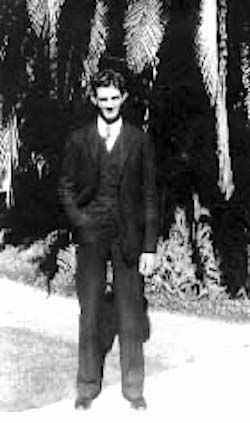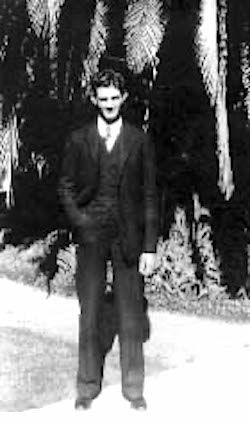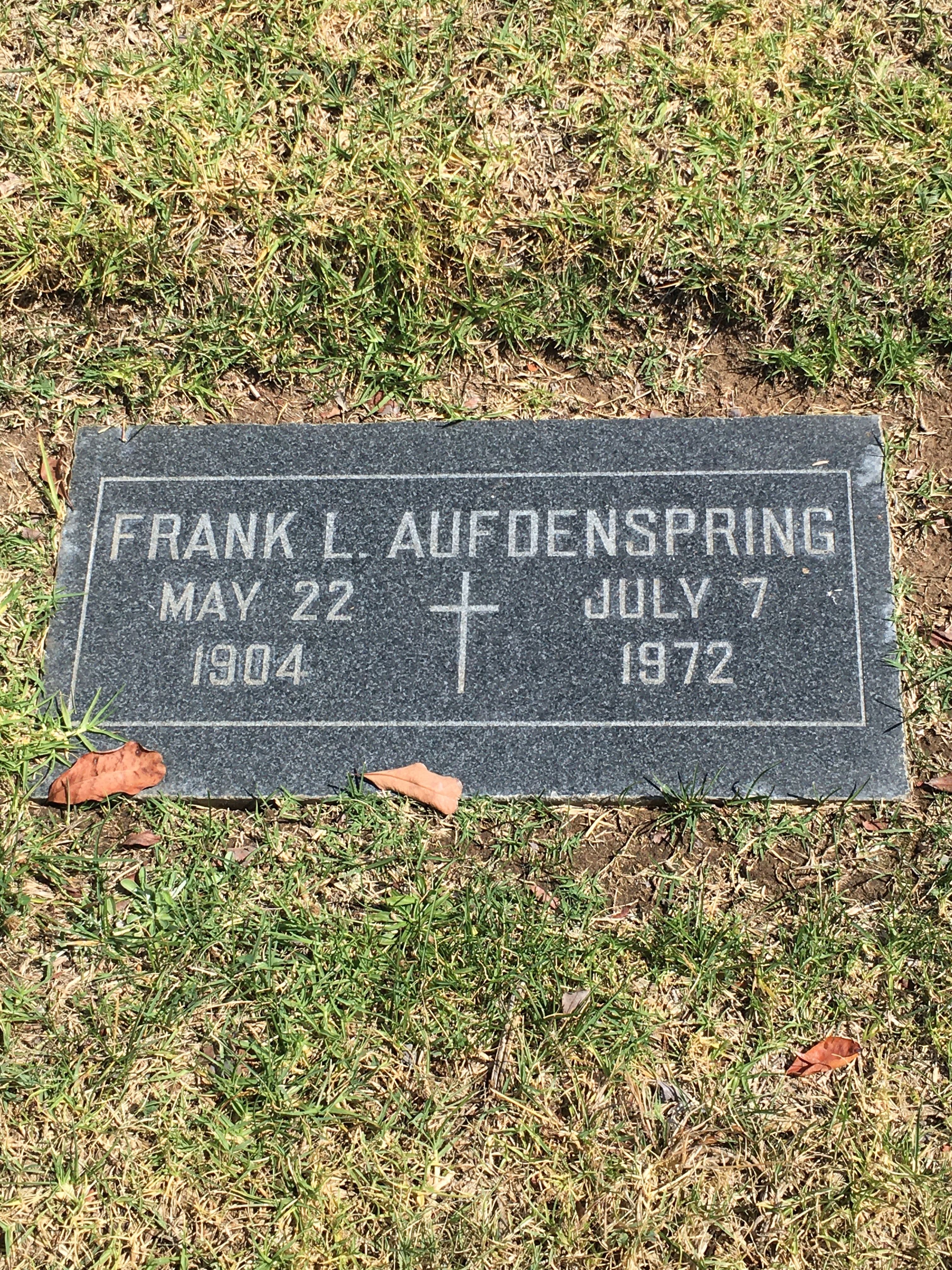____________________________________
A 1929 Borrego Valley Memoir
In his own words:
In the year 1929, we left the County Surveyors office at the County Courthouse in San Diego, to make a location for a new road to replace the existing one lane dirt road from the bottom of Banner Grade to the Imperial County line; there to meet John Rice of the Imperial County Surveyors office, who was making his survey from Kane Springs to meet us at the common county line.
Our first stop was a Joe Foster's ranch, N. E. of Lakeside, to talk to Mr. Foster, who had been the San Diego County Supervisor of that District of San Diego County for many years and for his suggestions at the new road location. We then drove up Mussey Grade, "which is not in existence anymore, due to San Vincente Dam" to Ramona, where we stayed at the Kenilworth Inn as guests of the management, namely, Mr. and Mrs. George Rogues, of whom there are some persons still alive who would drive to Ramona to taste and eat their chicken dinners family style. 10 to 14 people to a table and all you could eat.
On the way to Julian where we checked into the Julian Hotel, operated by Mr. and Mrs. Jacobs at the time, we then went up to the local garage operated by Blanc and Birdsell for a check-up on our truck. Knowing that at the bottom of Banner, we would be on the desert and our work would commence. We then went across the street to Myer Ruby's grocery store to buy enough food to see us through until we could find a camp-site in Borrego Valley.
I may say here that there was some sort of road, two wagon tracks cross Rancho San Felipe into Sentenac Canyon, crossed the bridge, thus what was to become our swimming hole. "Look at that water", then intio the San Felipe river bed and at the junction of the San Felipe and Grapevine Canyon, there was a line camp consisting of a shack and corral, owned by the Jasper family of Montezuma Valley, to the north, who ranged cattle in this area. One of their watering holes for their stock was Yaqui Wells.
We finally arrived in Borrego Valley, and started looking for a camp-site. We talked to Mr. Wynn who had the general store and also was the postmaster. He suggested that we go about 3/4 (plus or minus) miles east of his place, past the school house to the Williams Ranch, which you cannot miss, as it has the only palm tree on the desert floor and a Artesian Well, which will give you enough water for your needs.
We found the ranch where we were to live for quite a while, set up our tents, one for the cooks kitchen and eating place, and ours for sleeping.
After we found camp-site and got established on it, the next thing to do was get a cook, so back to Julian to find one. I think we were very fortunate in finding the man who knew the Borrego desert and was willing to take care of us foodwise, namely, Bill Garlette.
I am sure that there are some of his relatives still living in the Julian area. He would give us a good breakfast of ham or bacon and eggs. We put in long hours per day, his lunches which we took with us consisted of canned tomatoes, peaches, apricots, pineapple and pears. No heavy foods like meat sandwiches, etc. and after our days work 10 hours or more, we returned to camp and he had prepared a supper for us, consisting of a huge steak, potatoes and a vegetable plus his dessert concoction.
This will probably astound the present day engineers and designers of the State of Calif. Hwy Dept. as to how the location work was done of a road now in use thru the desert country of Borrego Valley, known as State Hwy #78, and how we did it in those days compared to todays.
Then comes the Prison Camp, located at the junction of State Hwy #78 and Yaqui Pass Road, now known as Tamarisk Park for camping purposes. The prisoners in the camp were to build the road after the construction completion of the prison camp. We moved from our camp on the Williams ranch in Borrego Valley, to the prison camp as our headquarters.
The prison camp was established by the Board of Supervisors and operated under the direction of Sheriff Cooper, who appointed Harlan Wilson Sr. as superintendent. The camp was an experiment at that time, the guards wearing a six shooter on their hips and a rifle in there arms, but that didn't last too long, as the prisoners were in for petty charges so it became an honor camp, no guns carried by the guards.
Then on to my old prospector, the basis of my story.
His name was either Hartmann or Hermann.He had jumped ship from a German freighter in San Francisco at the age of 17 years to become a gold prospector. After prospecting in the Mother Lode country, in Northern California without any success, he came south to prospect the Chocolate Mts. on the eastern side of Imperial Valley, and the San Ysidro Mts. on the westerly side of Boreggo Valley, spending his time, divded these two Mt. ranges for years trying to find gold. As to this information written above, we conversed in the German Language.
How he managed to exist is beyond me, having to take care of his livelyhood and his transporttion consisting of a spring wagon pulled by two Burros and his little dog. I have often wondered what happened to him, did he die in some lonesome place on the desert and what happened to his two burros and his dog. A man who followed his own way of life, a man who tried and lost. (Back tracking on the old prospector)
One of the requirements of the surveying and constuction of a new road is to make ties, that is, Bearing and Distance to a section or 1/4 corner established by the Surveyors General Office, in their sectionizing of townships and sections in the area which made for a lot of foot work to find one or more of these corners. We spent many days searching for these corners, but found none. In my searching I found a Gold Dry Washer, in the bed of a wash, complete with the screen, baffles and bellows. Could that be the place my old prospector was going back to, to try again.
Well, I am going back after 43 years to see if I can find that Dry Washer. If I do, I want to present it to the San Diego Historical Society, with a blown up picture of my old prospector and myself finding it.
If I do not find it, this is just a part of the story of a paved road into our desert, part of San Diego county, now known as State Hwy #78.
(Note: Frank L. Aufdenspring died before he got back to the desert that year.)
source: http://aufdenspring.com/frla.html
____________________________________
A 1929 Borrego Valley Memoir
In his own words:
In the year 1929, we left the County Surveyors office at the County Courthouse in San Diego, to make a location for a new road to replace the existing one lane dirt road from the bottom of Banner Grade to the Imperial County line; there to meet John Rice of the Imperial County Surveyors office, who was making his survey from Kane Springs to meet us at the common county line.
Our first stop was a Joe Foster's ranch, N. E. of Lakeside, to talk to Mr. Foster, who had been the San Diego County Supervisor of that District of San Diego County for many years and for his suggestions at the new road location. We then drove up Mussey Grade, "which is not in existence anymore, due to San Vincente Dam" to Ramona, where we stayed at the Kenilworth Inn as guests of the management, namely, Mr. and Mrs. George Rogues, of whom there are some persons still alive who would drive to Ramona to taste and eat their chicken dinners family style. 10 to 14 people to a table and all you could eat.
On the way to Julian where we checked into the Julian Hotel, operated by Mr. and Mrs. Jacobs at the time, we then went up to the local garage operated by Blanc and Birdsell for a check-up on our truck. Knowing that at the bottom of Banner, we would be on the desert and our work would commence. We then went across the street to Myer Ruby's grocery store to buy enough food to see us through until we could find a camp-site in Borrego Valley.
I may say here that there was some sort of road, two wagon tracks cross Rancho San Felipe into Sentenac Canyon, crossed the bridge, thus what was to become our swimming hole. "Look at that water", then intio the San Felipe river bed and at the junction of the San Felipe and Grapevine Canyon, there was a line camp consisting of a shack and corral, owned by the Jasper family of Montezuma Valley, to the north, who ranged cattle in this area. One of their watering holes for their stock was Yaqui Wells.
We finally arrived in Borrego Valley, and started looking for a camp-site. We talked to Mr. Wynn who had the general store and also was the postmaster. He suggested that we go about 3/4 (plus or minus) miles east of his place, past the school house to the Williams Ranch, which you cannot miss, as it has the only palm tree on the desert floor and a Artesian Well, which will give you enough water for your needs.
We found the ranch where we were to live for quite a while, set up our tents, one for the cooks kitchen and eating place, and ours for sleeping.
After we found camp-site and got established on it, the next thing to do was get a cook, so back to Julian to find one. I think we were very fortunate in finding the man who knew the Borrego desert and was willing to take care of us foodwise, namely, Bill Garlette.
I am sure that there are some of his relatives still living in the Julian area. He would give us a good breakfast of ham or bacon and eggs. We put in long hours per day, his lunches which we took with us consisted of canned tomatoes, peaches, apricots, pineapple and pears. No heavy foods like meat sandwiches, etc. and after our days work 10 hours or more, we returned to camp and he had prepared a supper for us, consisting of a huge steak, potatoes and a vegetable plus his dessert concoction.
This will probably astound the present day engineers and designers of the State of Calif. Hwy Dept. as to how the location work was done of a road now in use thru the desert country of Borrego Valley, known as State Hwy #78, and how we did it in those days compared to todays.
Then comes the Prison Camp, located at the junction of State Hwy #78 and Yaqui Pass Road, now known as Tamarisk Park for camping purposes. The prisoners in the camp were to build the road after the construction completion of the prison camp. We moved from our camp on the Williams ranch in Borrego Valley, to the prison camp as our headquarters.
The prison camp was established by the Board of Supervisors and operated under the direction of Sheriff Cooper, who appointed Harlan Wilson Sr. as superintendent. The camp was an experiment at that time, the guards wearing a six shooter on their hips and a rifle in there arms, but that didn't last too long, as the prisoners were in for petty charges so it became an honor camp, no guns carried by the guards.
Then on to my old prospector, the basis of my story.
His name was either Hartmann or Hermann.He had jumped ship from a German freighter in San Francisco at the age of 17 years to become a gold prospector. After prospecting in the Mother Lode country, in Northern California without any success, he came south to prospect the Chocolate Mts. on the eastern side of Imperial Valley, and the San Ysidro Mts. on the westerly side of Boreggo Valley, spending his time, divded these two Mt. ranges for years trying to find gold. As to this information written above, we conversed in the German Language.
How he managed to exist is beyond me, having to take care of his livelyhood and his transporttion consisting of a spring wagon pulled by two Burros and his little dog. I have often wondered what happened to him, did he die in some lonesome place on the desert and what happened to his two burros and his dog. A man who followed his own way of life, a man who tried and lost. (Back tracking on the old prospector)
One of the requirements of the surveying and constuction of a new road is to make ties, that is, Bearing and Distance to a section or 1/4 corner established by the Surveyors General Office, in their sectionizing of townships and sections in the area which made for a lot of foot work to find one or more of these corners. We spent many days searching for these corners, but found none. In my searching I found a Gold Dry Washer, in the bed of a wash, complete with the screen, baffles and bellows. Could that be the place my old prospector was going back to, to try again.
Well, I am going back after 43 years to see if I can find that Dry Washer. If I do, I want to present it to the San Diego Historical Society, with a blown up picture of my old prospector and myself finding it.
If I do not find it, this is just a part of the story of a paved road into our desert, part of San Diego county, now known as State Hwy #78.
(Note: Frank L. Aufdenspring died before he got back to the desert that year.)
source: http://aufdenspring.com/frla.html
Family Members
Sponsored by Ancestry
Advertisement
Explore more
Sponsored by Ancestry
Advertisement






